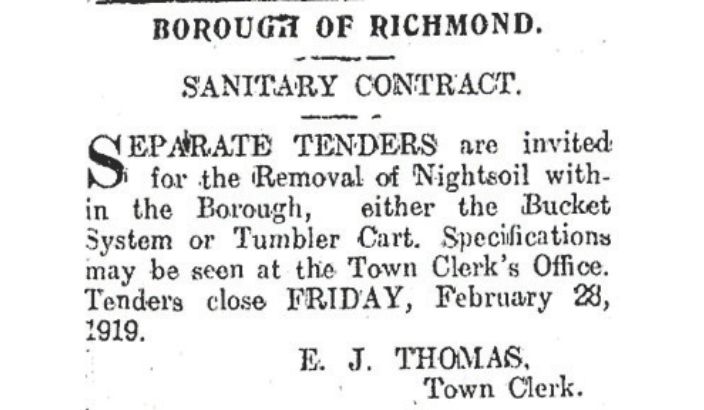The matter of Richmond’s sanitary conditions

The council tenders for night soil removal. Photo: Nelson Evening Mail 1919.
As Richmond grew, so too did its problem of how to handle the sanitation issue.
Residents had long drops on their properties or would use a bucket, especially for night soil that they would then deposit in their backyards. One could only imagine the stench in the summer months.
In May 1901, Mr McRae, a new member of the Richmond Council, in his first speech passed on his opinion that the sanitary condition of the borough should be considered at the earliest date possible. In July, the council began to investigate the ‘septic tank system’ for treating sewage.
By late 1905, the Council had made some improvements in the method of drainage and ways of disposing of night soil.
They decided that the village was too small to go in for any scheme, but through representation from the Department of Health, many cesspit privies were removed and pan privies substituted.
For slop water, soak pits were provided in certain houses that had previously been polluting a stream.
Four years later the new mayor, Mr A. Sheat, submitted several matters that should be dealt with in the near future, with one being the establishment of a sanitary service.
In May 1909, Richmond Council brought in a special sanitary rate of 6d in the pound on the rateable property within the area bounded by and fronting on Salisbury Rd, William, Edward, Queen to Hill St, Wensley Rd, Oxford St, Bell’s Rd, Waverley St, Gladstone Rd to Appleby Rd, Lower Queen St to McShanes Rd, Beach Rd north and south side of Queen St, to cover the cost of carrying on a night soil service.
Another five years passed and the issue of sanitation was still a problem.
In 1914, Messrs J. Hunt and W. Harkness, on behalf of Richmond School, waited on the Education Board regarding the dreadful conditions at the school. The board expressed astonishment at the conditions at the school, commenting that the borough needed to ‘wake up’ and institute a modern system of drainage. This was followed by a letter expressing their views. Others added their voice to the situation calling it disgraceful for there to be no sewerage system.
In July 1916, Albert Rainbow Tuffnell informed the council that it was high time that they took steps to begin a night soil system which resulted in a committee set up to investigate the matter.
However, the wheels of progress moved slowly with no real improvements made by 1918 when ‘Worried Mother’ wrote to the papers to bring attention to the disgraceful state still existing in Richmond. She pointed out that for the last three or four years diphtheria and scarlet fever had broken out in the district. She commented that all you had to do was to walk down the main street to see and smell for yourself.
In March 1919, the Council invited tenders for the management of night soil removal to which the lowest tender for a bucket system was accepted. The ensuing years, through pressure brought on by a growing town, demanded that sanitation was uppermost on the minds of the councillors and that improvements were progressed as, and when, needed. Fast forward to more modern times, in 1981 the Bell Island Sewerage Treatment Plant was erected, opening in 1983.
